The NVIDIA GeForce GTX 980 Ti Review
by Ryan Smith on May 31, 2015 6:00 PM ESTCompute
Shifting gears, we have our look at compute performance. Since GTX Titan X has no compute feature advantage - no fast double precision support like what's found in the Kepler generation Titans - the performance difference between the GTX Titan X and GTX 980 Ti should be very straightforward.
Starting us off for our look at compute is LuxMark3.0, the latest version of the official benchmark of LuxRender 2.0. LuxRender’s GPU-accelerated rendering mode is an OpenCL based ray tracer that forms a part of the larger LuxRender suite. Ray tracing has become a stronghold for GPUs in recent years as ray tracing maps well to GPU pipelines, allowing artists to render scenes much more quickly than with CPUs alone.
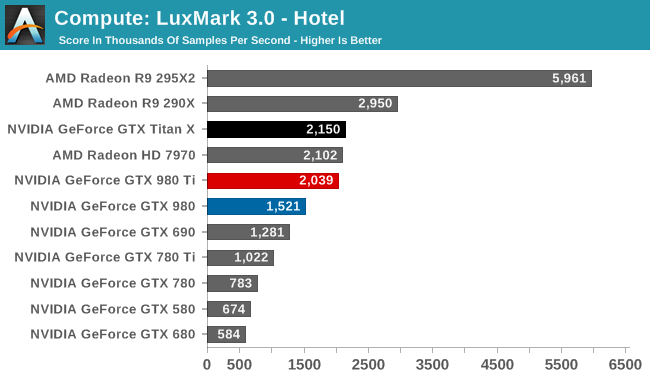
With the pace set for GM200 by GTX Titan X, there’s little to say here that hasn’t already been said. Maxwell does not fare well in LuxMark, and while GTX 980 Ti continues to stick very close to GTX Titan X, it none the less ends up right behind the Radeon HD 7970 in this benchmark.
For our second set of compute benchmarks we have CompuBench 1.5, the successor to CLBenchmark. CompuBench offers a wide array of different practical compute workloads, and we’ve decided to focus on face detection, optical flow modeling, and particle simulations.
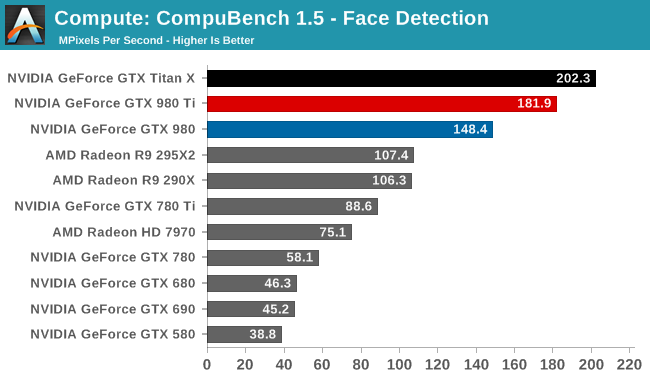
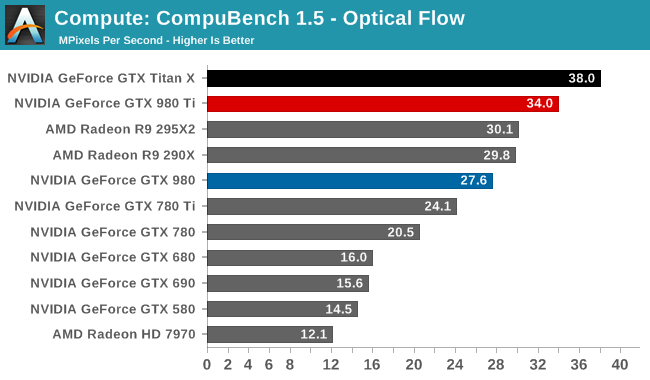
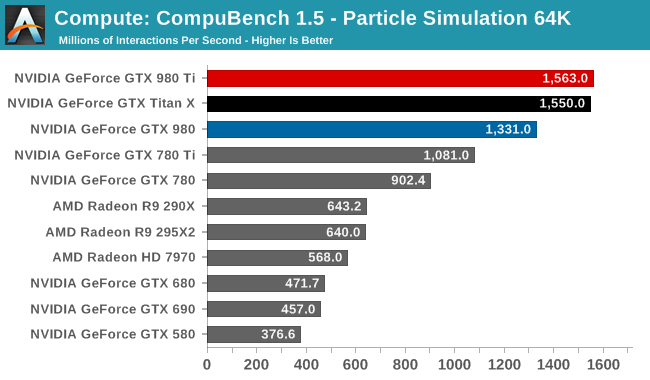
Although GTX T980 Ti struggled at LuxMark, the same cannot be said for CompuBench. Though taking the second spot in all 3 sub-tests - right behind GTX Titan X - there's a bit wider of a gap than normal between the two GM200 cards, causing GTX 980 Ti to trail a little more significantly than in other tests. Given the short nature of these tests, GTX 980 Ti doesn't get to enjoy its usual clockspeed advantage, making this one of the only benchmarks where the theoretical 9% performance difference between the cards becomes a reality.
Our 3rd compute benchmark is Sony Vegas Pro 13, an OpenGL and OpenCL video editing and authoring package. Vegas can use GPUs in a few different ways, the primary uses being to accelerate the video effects and compositing process itself, and in the video encoding step. With video encoding being increasingly offloaded to dedicated DSPs these days we’re focusing on the editing and compositing process, rendering to a low CPU overhead format (XDCAM EX). This specific test comes from Sony, and measures how long it takes to render a video.

Traditionally a benchmark that favors AMD, GTX 980 Ti fares as well as GTX Titan X, closing the gap some. But it's still not enough to surpass Radeon HD 7970, let alone Radeon R9 290X.
Moving on, our 4th compute benchmark is FAHBench, the official Folding @ Home benchmark. Folding @ Home is the popular Stanford-backed research and distributed computing initiative that has work distributed to millions of volunteer computers over the internet, each of which is responsible for a tiny slice of a protein folding simulation. FAHBench can test both single precision and double precision floating point performance, with single precision being the most useful metric for most consumer cards due to their low double precision performance. Each precision has two modes, explicit and implicit, the difference being whether water atoms are included in the simulation, which adds quite a bit of work and overhead. This is another OpenCL test, utilizing the OpenCL path for FAHCore 17.
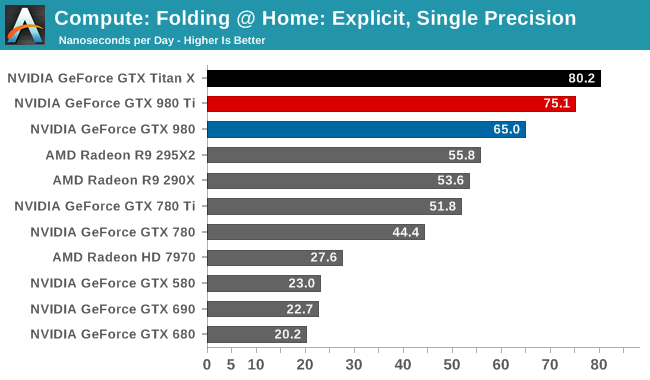
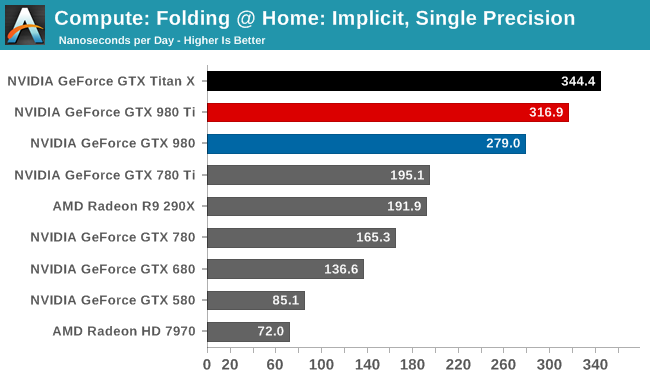
Folding @ Home’s single precision tests reiterate GM200's FP32 compute credentials. Second only to GTX Titan X, GTX 980 Ti fares very well here.
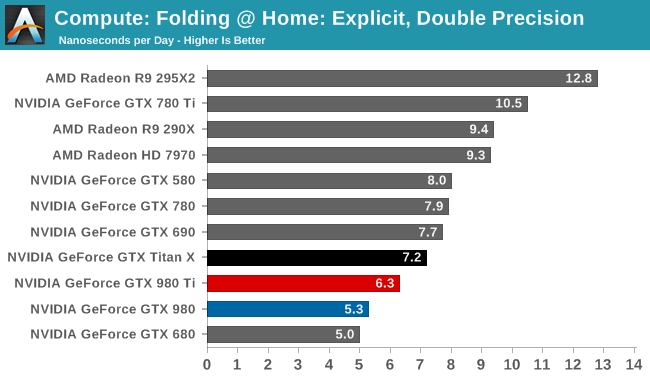
Meanwhile Folding @ Home’s double precision test reiterates GM200's poor FP64 compute performance. At 6.3ns/day, it, like the GTX Titan X, occupies the lower portion of our benchmark charts, below AMD's cards and NVIDIA's high-performnace FP64 cards.
Wrapping things up, our final compute benchmark is an in-house project developed by our very own Dr. Ian Cutress. SystemCompute is our first C++ AMP benchmark, utilizing Microsoft’s simple C++ extensions to allow the easy use of GPU computing in C++ programs. SystemCompute in turn is a collection of benchmarks for several different fundamental compute algorithms, with the final score represented in points. DirectCompute is the compute backend for C++ AMP on Windows, so this forms our other DirectCompute test.

We end up ending our benchmarks where we started: with the GTX 980 Ti slightly trailing the GTX Titan X, and with the two GM200 cards taking the top two spots overall. So as with GTX Titan X, GTX 980 Ti is a force to be reckoned with for FP32 compute, which for a pure consumer card should be a good match for consumer compute workloads.










290 Comments
View All Comments
Oxford Guy - Monday, June 1, 2015 - link
I'm sure you posted that from your 65nm processor and 80nm GPU.godrilla - Thursday, June 4, 2015 - link
Because next shrink is in the 3d chips plus hbm category and that should be amazing performance leap.Gastec - Sunday, September 4, 2016 - link
Oh yeah, that's "1337 5p34k" for ya! :PWreckage - Sunday, May 31, 2015 - link
Wait until AMD tries to sell you a rebadge for that much.Rezurecta - Sunday, May 31, 2015 - link
I don't understand the rage about rebadge all of a sudden. GPU has been doing this for YEARS!Anyway, nice card from Nvidia for a decent price.
dragonsqrrl - Sunday, May 31, 2015 - link
Don't mix up traditional rebadging and what AMD is doing with their upcoming lineup, it's unprecedented. It's also worrisome, and it's clearly a big problem for AMD. What does it say about the state of the company and their R&D budget that they'll only have 1 new GPU this coming generation? One of the big problems AMD is currently facing, amongst many other things, are their profit margins. In order to compete they're selling larger, more expensive GPU's attached to more complex memory interfaces relative to the competition, and that won't change much this coming generation as a result of these top to bottom rebadges. The situation is really becoming quite analogous to their CPU's, which should raise alarms for any informed enthusiast. It's a less than ideal situation, to put it lightly.Azix - Sunday, May 31, 2015 - link
If you post this after their launch then maybe I'd understand. As it is their Chips are almost certainly not rebadged because they aren't on TSMC and will include hardware improvements. They maybe be based on hawaii or w/e but not even nvidia managed to put out more than 2 new cards during their major launch last year. Considering this is likely the last year of 28nm launches, it may make sense for them to put out an entire line of modified chips and be done with the 300 series. Keeping it fresh till next year when they can do 2-3 on a smaller process.dragonsqrrl - Sunday, May 31, 2015 - link
"If you post this after their launch then maybe I'd understand."You realize I could just give the exact same response to the rest of your comment. But I won't.
"As it is their Chips are almost certainly not rebadged because they aren't on TSMC and will include hardware improvements.",
That's interesting, I haven't heard anything about AMD switching fabs for the 300 series. Source?
"They maybe be based on hawaii or w/e but not even nvidia managed to put out more than 2 new cards during their major launch last year."
Not quite a straight comparison there, since Nvidia also launched a new architecture with the 750Ti. Thus far we've gotten 4 new GPU's (not just cards) based on Maxwell. And we're not just talking launch here. All indications point to Fiji as the only new GPU of the coming generation for AMD. And what's more, it might not even be an updated architecture. The rest of the lineup will likely be refreshes of Hawaii, Tonga, Pitcairn, and Bonaire, ranging from GCN 1.2-1.0, with at most manufacturing revisions to improve efficiency. Again it's very important to put this in perspective, in the context of what these GPU's will be competing against. They range in feature set, and in power efficiency, none of which is anywhere close to par with Maxwell, and it's going to be very difficult for AMD to compete with this lineup for another generation. It's not a good situation for AMD. "Keeping it fresh"? How you came to spin your conclusion the way you did is beyond me.
ImSpartacus - Monday, June 1, 2015 - link
Be nice. The guy is basically telling you at this point.ImSpartacus - Monday, June 1, 2015 - link
trolling***